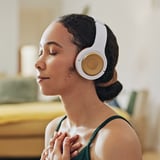Most of us already have some personal experience with the power of sound – whether it’s a specific frequency that keeps you calm, or the white noise that helps you sleep at night. Taking this basic concept one step further, scientists are now harnessing the healing properties of sound to make a positive impact on our health. Although research is still in its early stages, sound healing is already being used on a physiological, neurological, and biochemical level to reduce anxiety, facilitate better sleep, ease pain, and strengthen the musculoskeletal system.
We understand that using sound as medicine might seem a little far-fetched at first, but the science behind it may have you singing a different tune. To find out more, we spoke to sound healing experts about the benefits of sound healing, and what you should know before diving in yourself. Read on to learn how sound healing really works, what it’s best used for, and whether or not sound healing could actually help you.
What Is Sound Healing?
You may have already been introduced to sound healing via sound baths – which typically use singing bowls – but gongs, chimes, and resonant instruments like tuning forks are also used to create frequencies, says Lindsay Monal, sound meditation practitioner and registered yoga teacher at YogaRenew. “Through these sounds, we can influence our brain waves and help bring our minds from an active thinking state (beta brain waves), to a more relaxed and meditative (alpha waves), or even dreamlike state (theta waves),” Monal tells POPSUGAR. “We can intentionally use sound to move us from a state of stress or anxiety, into a restful state, where our bodies can naturally recover and heal.”
How Does Sound Healing Work?
Sound healing works in a number of ways, starting with the function of frequencies. “If I strike [a] middle C tuning fork and hold it next to the other middle C tuning fork, [it] will start to vibrate and they don’t even touch. That’s called resonant frequency,” explains Paul Harris, ND and Clinic Director at Soaak Clinics. Resonant frequencies can be used to help other cells in the body resonate at their best, or “optimal” frequencies. This process is thought to restore balance, instill a sense of calm, and even reduce pain.
Another important process in sound frequency therapy is called entrainment, which describes the synchronization of two vibrating systems. “Anytime there are two oscillating or vibrating frequencies in nature, over time, they will naturally start to synchronize with one another,” Monal says. Knowing this, we can intentionally use audible frequencies to alter our brain waves. These frequencies can also be used to communicate with the vagus nerve – the main part of your parasympathetic nervous system – which is directly connected to the eardrum. This is the system responsible for getting you out of “fight or flight” mode and into a more relaxed, resting state. “Sound meditation helps move the body and brain into a more relaxed state, through the entrainment of brainwaves, and helps reduce the perception of and intensity of the sensations associated with pain,” Monal explains.
On a neurological level, sound healing also works in a few different ways. One study showed that low frequency vibratory sound in the 10–100 Hz range facilitated increased neurite growth, with others finding that low frequency vibration can affect neural differentiation on a cellular level. The proprioceptive system, or the senses responsible for our perception of movement, action, and location, is also extremely sensitive to vibration. Knowing this, one study used sound vibration treatments to stimulate the proprioception pathways in people with cerebral palsy, leading to improvements in spasticity and gross motor function.
Benefits of Sound Healing
Generally speaking, studies and experts have claimed that sound healing has a plethora of physical benefits, including:
- Lower blood pressure
- Pain relief
- Reduced inflammation
- Less muscle tension
Beyond these physical benefits, Dr. Harris has also seen the mental effects of sound frequency therapy in his own clinical experience. “When we do EKGs and EEGs and those types of things, you can see a stabilization in the brainwaves,” he says, referring to the medical tests used to study the brains of patients who have used sound healing. Other potential mental benefits include:
- Anxiety relief
- Enhanced concentration
- Improved sleep quality
- Decreased depression
- Better mood
As new research continues to emerge, studies indicate that sound healing may be especially effective for pain management. One study of fibromyalgia patients found that low-frequency sound stimulation helped participants sit and stand without pain for longer. While studying how sound suppresses pain in mice, a team of scientists from the National Institute of Health (NIH) also discovered that low-intensity white noise led to reduced neuron activity in the thalamus (the part of the brain responsible for sensory processing).
Monal adds that sound frequency therapy can help with a wide range of concerns, ranging from chronic pain conditions to sore muscles. If you’re still skeptical, Monal encourages you to try it out and see how you feel afterwards. “There is evidence out there that this really works, so my suggestion would be to suspend your disbelief, give it a few tries, and let your experience speak for itself.”
Music Therapy vs. Sound Healing
It’s easy to get the two mixed up. Although music therapy and sound healing work in similar ways, there are some key differences. Music therapy may involve activities like musical guided meditations, lyric analysis, or drawing along to music. Music therapy also takes into consideration personal preference for genre, focusing on the emotion music evokes, rather than the natural neurological response to sound vibration. Still, music therapy has also proven to be quite powerful, helping people with chronic aphasia regain their speech, and allowing people with PTSD and other forms of trauma to better process their emotions.
Chandler Plante is an assistant editor for POPSUGAR Health & Fitness. Previously, she worked as an editorial assistant for People magazine and contributed to Ladygunn, Millie, and Bustle Digital Group. In her free time, she overshares on the internet, creating content about chronic illness, beauty, and disability.
49344420




